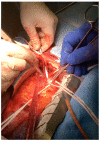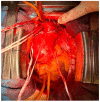Cerebral Perfusion and Neuromonitoring during Complex Aortic Arch Surgery: A Narrative Review
- PMID: 37240576
- PMCID: PMC10218889
- DOI: 10.3390/jcm12103470
Cerebral Perfusion and Neuromonitoring during Complex Aortic Arch Surgery: A Narrative Review
Abstract
Complex ascending and aortic arch surgery requires the implementation of different cerebral protection strategies to avoid or limit the probability of intraoperative brain damage during circulatory arrest. The etiology of the damage is multifactorial, involving cerebral embolism, hypoperfusion, hypoxia and inflammatory response. These protective strategies include the use of deep or moderate hypothermia to reduce the cerebral oxygen consumption, allowing the toleration of a variable period of absence of cerebral blood flow, and the use of different cerebral perfusion techniques, both anterograde and retrograde, on top of hypothermia, to avoid any period of intraoperative brain ischemia. In this narrative review, the pathophysiology of cerebral damage during aortic surgery is described. The different options for brain protection, including hypothermia, anterograde or retrograde cerebral perfusion, are also analyzed, with a critical review of the advantages and limitations under a technical point of view. Finally, the current systems of intraoperative brain monitoring are also discussed.
Keywords: aortic surgery; cerebral perfusion; cerebral protection; hypothermic circulatory arrest; innominate artery; near-infrared spectroscopy.
Conflict of interest statement
The authors declare no conflict of interest.
Figures
References
-
- Oeveren W.V. Neurological damage due to coagulation and fat release during cardiopulmonary bypass: Deutsche Forschungsgemeinschaft. BioMed Cent. 1999;4:1–2.
Publication types
LinkOut - more resources
Full Text Sources



